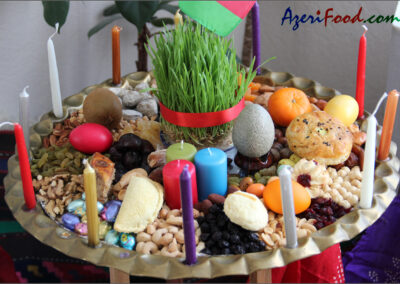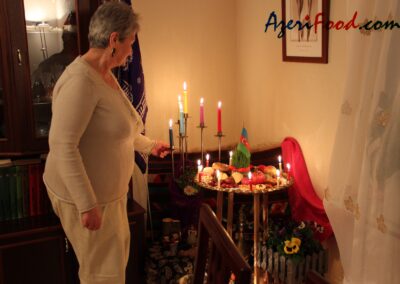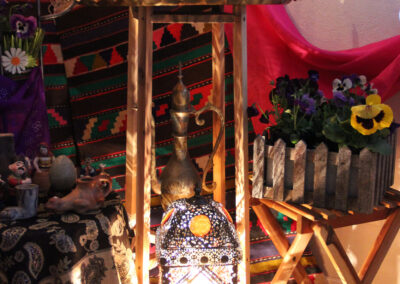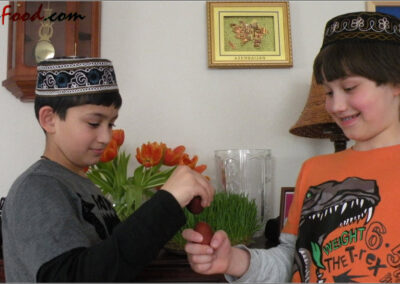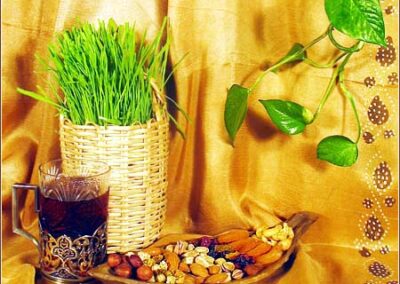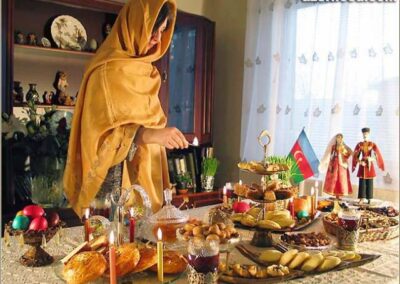Novruz
The most beloved, ancient, cheerful Azerbaijani holiday, eagerly awaited by both children and adults. With his arrival, on March 21st, spring comes and nature awakens. Novruz is full of customs and traditions passed down from generation to generation for centuries, because its roots go back to the times of Zoroastrianism. Novruz is a holiday of rebirth, peace and kindness. The fuss itself is indescribable, when the whole family comes together and prepares Novruz sweets – shekyarbura, baklava, shorgogal, paints eggs and tells entertaining stories. It is also mandatory to grow syamyani – sprouted wheat seeds, personifying the origin of life. On the thirteenth day of Novruz, the Syamyans are thrown into the river, making a wish.
In Azerbaijan, Novruz is also identified with folk festivals and games, jumping over a fire, divination, lighting candles, and most importantly communication with loved ones and relatives. The four Tuesdays that precede Novruz are called the four symbols of nature – Water, Fire, Earth and Air.
Novruz calendar 2022
15.02.2022 – unofficial first çarşänbä ahshama. It is popularly called Yalanchi Çärşänbä akhsham.
22.02.2022 – official first çarşänbä ahşama, Su Çärşänbä (water).
01.03.2022 – the second çärşänbä ahşama, Od Čärşänbä (fire).
08.03.2022 – third Çärşänbähşa ahşama, Yel (Hava) Čärşänbä (air).
15.03.2022 – the fourth, last Çärşänbä ahşama, Torpag Čäršänbä (land).
19.03.2022 – Bayram Akhshama, pre-night.
20.03.2022 – Bayram, holiday.
Traditions on Novruz
In Yalanchi, the people usually begin to prepare for Novruz little by little. They buy nuts, hazelnuts, dried fruits. Make a calendar for the next month.
The first, second and third çärşänbä ahshama family gathers at the table where a tray of dried fruits (yuski) is served, on which candles are lit. Be sure to have an apple, sweets, something golden on the tray. Usually these days they do not swear, but on the contrary, remember good days, play games, guess. The last çarshanbya ahsama is special. Then the main events of Novruz develop. We can say that this day begins Novruz itself, because the air becomes warmer, buds open on trees. In addition to the fact that there is a tray with dried fruits, the family gathers for a pre-holiday dinner. Be sure to do lobia-chilo, pilaf with beans for dinner. Novruz sweets, painted eggs, as well as syamyani – sprouted wheat – must be present. Candles are lit on every member of the family. After dinner, a fire is lit in the yard and jumped over it. Young people go from house to house, tossing hats (papah-atmag), which the owners of the house had to fill with fruits, sweets, baked. Young people walk, sing songs, dance. Girls usually guess on this day.
In the akhir çarshanbya akhshams, the graves of the dead are visited, where Novruz sweets and syamyani are brought. Prayers are recited in honor of the dead. On this evening, they also remember all the dead and say dua. Bayram ahshama takes place in much the same way as the last çarşänbä ahsama. Be sure to have fish on the pre-holiday table. The family should meet Novruz at home. Children are given gifts. Everyone should be dressed in new clothes. On the table there must be 7 items whose names begin with the letter “C”. The lights should be on in the house this evening. If there is an engaged girl in the family, then the groom’s side is brought to her by special honcha – honcha in her name.
On Bayram, the day of the holiday, people go to visit each other. First of all, the most adults are visited – the agsaggals of the family, and then other family members – uncles, aunts, brothers and sisters. Here you can see Novruz with our eyes. All photos were taken specifically for our website.
If you like it, share it!






